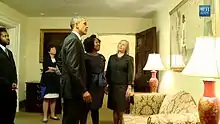The Problem We All Live With
The Problem We All Live With is a 1964 painting by Norman Rockwell that is considered an iconic image of the Civil Rights Movement in the United States.[2] It depicts Ruby Bridges, a six-year-old African-American girl, on her way to William Frantz Elementary School, an all-white public school, on November 14, 1960, during the New Orleans school desegregation crisis. Because of threats of violence against her, she is escorted by four deputy U.S. marshals; the painting is framed so that the marshals' heads are cropped at the shoulders.[3][4] On the wall behind her are written the racial slur "nigger" and the letters "KKK"; a smashed and splattered tomato thrown against the wall is also visible. The white protesters are not visible, as the viewer is looking at the scene from their point of view.[3] The painting is oil on canvas and measures 36 inches (91 cm) high by 58 inches (150 cm) wide.[5]
| The Problem We All Live With | |
|---|---|
 | |
| Artist | Norman Rockwell |
| Year | 1964 |
| Medium | Oil on canvas |
| Dimensions | 91 cm × 150 cm (36 in × 58 in) |
| Location | Norman Rockwell Museum[1] |
History

The painting was originally published as a centerfold in the January 14, 1964, issue of Look.[5] Rockwell had ended his contract with the Saturday Evening Post the previous year due to frustration with the limits the magazine placed on his expression of political themes, and Look offered him a forum for his social interests, including civil rights and racial integration.[3] Rockwell explored similar themes in Southern Justice (Murder in Mississippi) and New Kids in the Neighborhood;[6] unlike his previous works for the Post, The Problem We All Live With and these others place black people as sole protagonists, instead of as observers, part of group scenes, or in servile roles.[7][8] Like New Kids in the Neighborhood, The Problem We All Live With depicts a black child protagonist;[7] like Southern Justice, it uses strong light-dark contrasts to further its racial theme.[9]
While the subject of the painting was inspired by Ruby Bridges, Rockwell used a local girl, Lynda Gunn, as the model for his painting;[10] her cousin, Anita Gunn, was also used.[11] One of the marshals was modelled by William Obanhein.[11]
After the work was published, Rockwell received "sacks of disapproving mail", one example accusing him of being a race traitor.[11]
Legacy

At Bridges' suggestion, President Barack Obama had the painting installed in the White House, in a hallway outside the Oval Office, from July to October 2011. Art historian William Kloss stated, "The N-word there – it sure stops you. There's a realistic reason for having the graffiti as a slur, [but] it's also right in the middle of the painting. It's a painting that could not be hung even for a brief time in the public spaces [of the White House]. I'm pretty sure of that."[1] Bridges and Obama viewed the painting together on July 15, 2011, and he told her, "I think it's fair to say that if it hadn't been for you guys, I might not be here and we wouldn't be looking at this together."[12]
A copy of the painting was used to "dress" O. J. Simpson's house during his 1995 murder trial by defense attorney Johnnie Cochran. Cochran hoped to evoke the sympathy of visiting jurors, who were mostly black, by including "something depicting African-American history."[13]
See also
References
- Gerstein, Josh (August 24, 2011). "Norman Rockwell painting sends rare White House message on race". Politico. p. 1, 2.
- Solomon, Deborah (2013). American Mirror: The Life and Art of Norman Rockwell. New York: Farrar, Straus and Giroux. pp. 378. ISBN 9780374113094.
- Halpern, Richard (2006). Norman Rockwell: the underside of innocence. University of Chicago Press. pp. 124–31. ISBN 9780226314402.
- Greene, Bob (September 4, 2011). "America's glory in a civil rights painting". CNN.
- ""The Problem We All Live With," Norman Rockwell, 1963. Oil on canvas, 36" x 58". Illustration for "Look," January 14, 1964. Norman Rockwell Museum Collection. ©NRELC, Niles, IL". Norman Rockwell Museum. Retrieved 2011-08-26.
- "O say, can you see". The Economist. December 25, 1993 – January 7, 1994.
- Grant, Daniel (July 24, 1989). "Exhibit Offers Clues to Rockwell's Sentiments". Christian Science Monitor.
- "Exile on Main Street". The Economist. December 2, 1999.
- Claridge, Laura P (2001). Norman Rockwell: A Life. Random House. ISBN 9781588360649.
- Bradway, Rich (October 6, 2019). "Remembering Lynda Jean Gunn - Norman Rockwell Museum - The Home for American Illustration".
- Carson, Tom (19 February 2020). "The true story of the awakening of Norman Rockwell". Vox. Retrieved 27 November 2020.
- "Ruby Bridges visits with the President and her portrait". YouTube. Retrieved November 15, 2014.
- Bernstein, Richard, "Shedding Light on How Simpson's Lawyers Won", The New York Times, October 16, 1996.
External links
 Media related to The Problem We All Live With at Wikimedia Commons
Media related to The Problem We All Live With at Wikimedia Commons- President Obama talking with Ruby Bridges, The Problem We All Live With painting (YouTube.com-The White House channel)
- Detailed record of the painting via the Norman Rockwell Museum website
- 2020 Vox.com article about Rockwell and the painting